Words are
made up of morphemes.
A morpheme is the smallest meaningful unit of a word. We distinguish
root morphemes and affixational morphemes. The very term “morpheme”
is of the Greek origin (morphe
–
form). Can morphemes occur in speech as separate independent units?
They can, if a word consists of a single morpheme: he can, pen,
walk. But upon the whole morphemes are not
autonomous.
They occur in speech as consistent parts of words. Word
is the basic unit of a given language. The approach to the study of
the vocabulary in this country is lexicocentrical.
Any word is a semantic, grammatical and phonological unit and is
fully autonomous. Words are minimal free forms.
Different
morphemes play different roles in constructing words. Root
morphemes
carry the lexical meaning of the word making it the semantic centre.
Affixational
morphemes
fall into functional morphemes (inflexions, grammatical formants) and
derivational morphemes.
Functional
morphemes are dealt with in grammar and they are few in Modern
English: Ns (es), Ns, Ns’, -er, -est, Vs, Ves, -ing, -ed, -t, -n
(en).
Lexicology
deals with derivational
affixes.
They may be treated from the point of view of word-building
(in what way they derive new words) and from the point of view of
word-structure (what role they play in the structure of the word, as
a structural unit).
As far as
the morphemic composition of words is concerned we distinguish
monomorphemic
and polymorphemic
words. I,
bad, tree, go
– are monomorphemic words representing the root morpheme only.
Teacher,
loveableness, irreproachful, bookshop
–
are polymorphemic words consisting of root morphemes and affix,
morphemes or two root morphemes.
Affixational
derivational morphemes are subdivided into prefixes,
suffixes and
infixes.
An affix before the root-morpheme is called a
prefix: re-presentation,
un-willingly,
im-possible,
en-circle
and that following the root-morpheme – a
suffix: walk-er,
yellow-ish,
symbol-ism,
fellow-ship.
Affixes possess the part-of-speech meaning.
Structurally
we distinguish free
morphemes and bound
morphemes. Bound
morphemes function only as parts of words: —ness,
-ate, -hood, de-.
Bound
morphemes
among roots are presented by –ceive
(conceive, deceive), theor-
(theory, theoretical).
Infixes
(n
in stand) are
not productive in English.
Structural Types of English Words
When we
remove from a word all functional affixes (inflexions) we receive a
stem
(основа
слова).
The stem
expresses both lexical and part-of-speech meaning. It is the part of
a word which remains unchanged through its paradigm.
A
paradigm
is a system of grammatical forms of the word.
Stems
may be simple (root stems), derived (beautiful) and compound
(handbag).
A stem
containing one and more affixes is called a
derived stem.
When we
remove derivational affixes from the stem we receive the root
of the word – the
common element of words within a word family: hand,
handy, handiwork, handicraft, handful, free-handed, red-handed,
handbag, handcuffs.
The
morphlogical structure of the English language is such that the
majority of words are root
ones. It is the influence of the analytical structure of the
language.
For that
reason it is difficult to say to what part of speech words belong.
Word meaning can be modified by affixes (ad+fixus-L.). Affixes
express lexico-grammatical meanings and serve to build new words.
Prefixes
modify the meaning of words while by the addition of the suffix not
only the meaning is modified but the word itself is transferred to
another part of speech.
cf.: honest-dishonest,
carry-miscarry, archaic-pseudoarchaic, VS clever-cleverness,
present-presentation, work-worker, achieve-achievable.
From the point of view of the
morphological structure of English words we distinguish:
-
Simple words (root-words)
where the root coincides with the stem in form; -
Derived words (derivatives)
where the meaning of the root, the lexical nucleus is modified by
the potential meaning of suffixes; -
Compound words where two or
more stems are fused into semantic and structural whole. -
Compound derivatives or
derivational compounds constituted by two or more stem-morphemes
(roots) modified by an affix.
Simple or
root words predominate in speech communication, as we see from
average talk and reading. Root words are the most frequent lexical
units in English. Without special frequency counts the high frequency
value of the so-called “functional words” (prepositions,
articles, conjunctions, pronouns) is evident. As to the notional
words 60 % of the total number of nouns and 68,7 % of the total
number of adjectives used in Modern English are root words. In
dictionaries, however we find 18 % of nouns and 12,4 % of adjectives.
Derived words (38 % of nouns
and 12,4 % of adjectives) are, above all structural types. In
dictionaries derived nouns constitute 67 % of all the nouns, 86,3 %
of adjectives are derived words.
Compound words do not possess
a high frequency value – 2 % of nouns and 0,21 % of adjectives. The
number of compound words is steadily growing in the language. Thus,
prof. Mühler states that in 1943 there were 48 compound words with
“fire”, in 1960 – 61.
As all the words of the
English language are divisible it is possible to carry out 3 levels
of analysis of word structure.
I. Morphemic analysis
states the number of morphemes in a word and their types.
Thus un-believe-bal-ness
consists of 4 morphemes: one root morpheme and 3 affix morphemes.
I
Derivational or structural word-formation analysis shows the
structural correlation of the word with other words, the structural
patterns or rules on which we build words. We present structurally
correlative words in a set of binary oppositions. Each second element
of these oppositions may be derived from the corresponding first
elements; white = yellow = red
whitish
= yellowish = reddish
We may observe from
proportional oppositions that ish is their distinctive
feature. Any other word built according to this pattern contains this
component common to the whole group.
III. Analysis into
Immediate Constituents.
Immediate
Constituents are any of the two meaningful parts forming a larger
linguistic unity. Any word (not a simple one) is characterized by
morphological divisibility. The analysis into IC reveals the history
of the word and its motivation (we play back the process of its
construction). Let’s take, for example, remacadamized
(road). The analysis is binary and at each stage we may split the
word into 2 constituent parts only:
I.
remacadamize + ed II.
re + macadamize
or
re+macadamized
macadamize + ed
III.
macadamize
macadam
+ ize
Breaking the word into ICs we
observe in each cut the structural order of its constituents.
Finally the Ultimate
Constituents will look this way:
re + macadam + ize + ed.
If
the analysis is carried out correctly its results will coincide with
the result of morphemic analysis.
Соседние файлы в предмете [НЕСОРТИРОВАННОЕ]
- #
- #
- #
- #
- #
- #
- #
- #
- #
- #
- #
WORD STRUCTURE IN MODERN ENGLISH
I. The morphological structure of a word. Morphemes. Types of morphemes. Allomorphs.
II. Structural types of words.
III. Principles of morphemic analysis.
IV. Derivational level of analysis. Stems. Types of stems. Derivational types of words.
I. The morphological structure of a word. Morphemes. Types of Morphemes. Allomorphs.
There are two levels of approach to the study of word- structure: the level of morphemic analysis and the level of derivational or word-formation analysis.
Word is the principal and basic unit of the language system, the largest on the morphologic and the smallest on the syntactic plane of linguistic analysis.
It has been universally acknowledged that a great many words have a composite nature and are made up of morphemes, the basic units on the morphemic level, which are defined as the smallest indivisible two-facet language units.
The term morpheme is derived from Greek morphe “form ”+ -eme. The Greek suffix –eme has been adopted by linguistic to denote the smallest unit or the minimum distinctive feature.
The morpheme is the smallest meaningful unit of form. A form in these cases a recurring discrete unit of speech. Morphemes occur in speech only as constituent parts of words, not independently, although a word may consist of single morpheme. Even a cursory examination of the morphemic structure of English words reveals that they are composed of morphemes of different types: root-morphemes and affixational morphemes. Words that consist of a root and an affix are called derived words or derivatives and are produced by the process of word building known as affixation (or derivation).
The root-morpheme is the lexical nucleus of the word; it has a very general and abstract lexical meaning common to a set of semantically related words constituting one word-cluster, e.g. (to) teach, teacher, teaching. Besides the lexical meaning root-morphemes possess all other types of meaning proper to morphemes except the part-of-speech meaning which is not found in roots.
Affixational morphemes include inflectional affixes or inflections and derivational affixes. Inflections carry only grammatical meaning and are thus relevant only for the formation of word-forms. Derivational affixes are relevant for building various types of words. They are lexically always dependent on the root which they modify. They possess the same types of meaning as found in roots, but unlike root-morphemes most of them have the part-of-speech meaning which makes them structurally the important part of the word as they condition the lexico-grammatical class the word belongs to. Due to this component of their meaning the derivational affixes are classified into affixes building different parts of speech: nouns, verbs, adjectives or adverbs.
Roots and derivational affixes are generally easily distinguished and the difference between them is clearly felt as, e.g., in the words helpless, handy, blackness, Londoner, refill, etc.: the root-morphemes help-, hand-, black-, London-, fill-, are understood as the lexical centers of the words, and –less, -y, -ness, -er, re- are felt as morphemes dependent on these roots.
Distinction is also made of free and bound morphemes.
Free morphemes coincide with word-forms of independently functioning words. It is obvious that free morphemes can be found only among roots, so the morpheme boy- in the word boy is a free morpheme; in the word undesirable there is only one free morpheme desire-; the word pen-holder has two free morphemes pen- and hold-. It follows that bound morphemes are those that do not coincide with separate word- forms, consequently all derivational morphemes, such as –ness, -able, -er are bound. Root-morphemes may be both free and bound. The morphemes theor- in the words theory, theoretical, or horr- in the words horror, horrible, horrify; Angl- in Anglo-Saxon; Afr- in Afro-Asian are all bound roots as there are no identical word-forms.
It should also be noted that morphemes may have different phonemic shapes. In the word-cluster please , pleasing , pleasure , pleasant the phonemic shapes of the word stand in complementary distribution or in alternation with each other. All the representations of the given morpheme, that manifest alternation are called allomorphs/or morphemic variants/ of that morpheme.
The combining form allo- from Greek allos “other” is used in linguistic terminology to denote elements of a group whose members together consistute a structural unit of the language (allophones, allomorphs). Thus, for example, -ion/ -tion/ -sion/ -ation are the positional variants of the same suffix, they do not differ in meaning or function but show a slight difference in sound form depending on the final phoneme of the preceding stem. They are considered as variants of one and the same morpheme and called its allomorphs.
Allomorph is defined as a positional variant of a morpheme occurring in a specific environment and so characterized by complementary description.
Complementary distribution is said to take place, when two linguistic variants cannot appear in the same environment.
Different morphemes are characterized by contrastive distribution, i.e. if they occur in the same environment they signal different meanings. The suffixes –able and –ed, for instance, are different morphemes, not allomorphs, because adjectives in –able mean “ capable of beings”.
Allomorphs will also occur among prefixes. Their form then depends on the initials of the stem with which they will assimilate.
Two or more sound forms of a stem existing under conditions of complementary distribution may also be regarded as allomorphs, as, for instance, in long a: length n.
II. Structural types of words.
The morphological analysis of word- structure on the morphemic level aims at splitting the word into its constituent morphemes – the basic units at this level of analysis – and at determining their number and types. The four types (root words, derived words, compound, shortenings) represent the main structural types of Modern English words, and conversion, derivation and composition the most productive ways of word building.
According to the number of morphemes words can be classified into monomorphic and polymorphic. Monomorphic or root-words consist of only one root-morpheme, e.g. small, dog, make, give, etc. All polymorphic word fall into two subgroups: derived words and compound words – according to the number of root-morphemes they have. Derived words are composed of one root-morpheme and one or more derivational morphemes, e.g. acceptable, outdo, disagreeable, etc. Compound words are those which contain at least two root-morphemes, the number of derivational morphemes being insignificant. There can be both root- and derivational morphemes in compounds as in pen-holder, light-mindedness, or only root-morphemes as in lamp-shade, eye-ball, etc.
These structural types are not of equal importance. The clue to the correct understanding of their comparative value lies in a careful consideration of: 1)the importance of each type in the existing wordstock, and 2) their frequency value in actual speech. Frequency is by far the most important factor. According to the available word counts made in different parts of speech, we find that derived words numerically constitute the largest class of words in the existing wordstock; derived nouns comprise approximately 67% of the total number, adjectives about 86%, whereas compound nouns make about 15% and adjectives about 4%. Root words come to 18% in nouns, i.e. a trifle more than the number of compound words; adjectives root words come to approximately 12%.
But we cannot fail to perceive that root-words occupy a predominant place. In English, according to the recent frequency counts, about 60% of the total number of nouns and 62% of the total number of adjectives in current use are root-words. Of the total number of adjectives and nouns, derived words comprise about 38% and 37% respectively while compound words comprise an insignificant 2% in nouns and 0.2% in adjectives. Thus it is the root-words that constitute the foundation and the backbone of the vocabulary and that are of paramount importance in speech. It should also be mentioned that root words are characterized by a high degree of collocability and a complex variety of meanings in contrast with words of other structural types whose semantic structures are much poorer. Root- words also serve as parent forms for all types of derived and compound words.
III. Principles of morphemic analysis.
In most cases the morphemic structure of words is transparent enough and individual morphemes clearly stand out within the word. The segmentation of words is generally carried out according to the method of Immediate and Ultimate Constituents. This method is based on the binary principle, i.e. each stage of the procedure involves two components the word immediately breaks into. At each stage these two components are referred to as the Immediate Constituents. Each Immediate Constituent at the next stage of analysis is in turn broken into smaller meaningful elements. The analysis is completed when we arrive at constituents incapable of further division, i.e. morphemes. These are referred to Ultimate Constituents.
A synchronic morphological analysis is most effectively accomplished by the procedure known as the analysis into Immediate Constituents. ICs are the two meaningful parts forming a large linguistic unity.
The method is based on the fact that a word characterized by morphological divisibility is involved in certain structural correlations. To sum up: as we break the word we obtain at any level only ICs one of which is the stem of the given word. All the time the analysis is based on the patterns characteristic of the English vocabulary. As a pattern showing the interdependence of all the constituents segregated at various stages, we obtain the following formula:
un+ { [ ( gent- + -le ) + -man ] + -ly}
Breaking a word into its Immediate Constituents we observe in each cut the structural order of the constituents.
A diagram presenting the four cuts described looks as follows:
1. un- / gentlemanly
2. un- / gentleman / — ly
3. un- / gentle / — man / — ly
4. un- / gentl / — e / — man / — ly
A similar analysis on the word-formation level showing not only the morphemic constituents of the word but also the structural pattern on which it is built.
The analysis of word-structure at the morphemic level must proceed to the stage of Ultimate Constituents. For example, the noun friendliness is first segmented into the ICs: [frendlı-] recurring in the adjectives friendly-looking and friendly and [-nıs] found in a countless number of nouns, such as unhappiness, blackness, sameness, etc. the IC [-nıs] is at the same time an UC of the word, as it cannot be broken into any smaller elements possessing both sound-form and meaning. Any further division of –ness would give individual speech-sounds which denote nothing by themselves. The IC [frendlı-] is next broken into the ICs [-lı] and [frend-] which are both UCs of the word.
Morphemic analysis under the method of Ultimate Constituents may be carried out on the basis of two principles: the so-called root-principle and affix principle.
According to the affix principle the splitting of the word into its constituent morphemes is based on the identification of the affix within a set of words, e.g. the identification of the suffix –er leads to the segmentation of words singer, teacher, swimmer into the derivational morpheme – er and the roots teach- , sing-, drive-.
According to the root-principle, the segmentation of the word is based on the identification of the root-morpheme in a word-cluster, for example the identification of the root-morpheme agree- in the words agreeable, agreement, disagree.
As a rule, the application of these principles is sufficient for the morphemic segmentation of words.
However, the morphemic structure of words in a number of cases defies such analysis, as it is not always so transparent and simple as in the cases mentioned above. Sometimes not only the segmentation of words into morphemes, but the recognition of certain sound-clusters as morphemes become doubtful which naturally affects the classification of words. In words like retain, detain, contain or receive, deceive, conceive, perceive the sound-clusters [rı-], [dı-] seem to be singled quite easily, on the other hand, they undoubtedly have nothing in common with the phonetically identical prefixes re-, de- as found in words re-write, re-organize, de-organize, de-code. Moreover, neither the sound-cluster [rı-] or [dı-], nor the [-teın] or [-sı:v] possess any lexical or functional meaning of their own. Yet, these sound-clusters are felt as having a certain meaning because [rı-] distinguishes retain from detain and [-teın] distinguishes retain from receive.
It follows that all these sound-clusters have a differential and a certain distributional meaning as their order arrangement point to the affixal status of re-, de-, con-, per- and makes one understand —tain and –ceive as roots. The differential and distributional meanings seem to give sufficient ground to recognize these sound-clusters as morphemes, but as they lack lexical meaning of their own, they are set apart from all other types of morphemes and are known in linguistic literature as pseudo- morphemes. Pseudo- morphemes of the same kind are also encountered in words like rusty-fusty.
IV. Derivational level of analysis. Stems. Types of Stems. Derivational types of word.
The morphemic analysis of words only defines the constituent morphemes, determining their types and their meaning but does not reveal the hierarchy of the morphemes comprising the word. Words are no mere sum totals of morpheme, the latter reveal a definite, sometimes very complex interrelation. Morphemes are arranged according to certain rules, the arrangement differing in various types of words and particular groups within the same types. The pattern of morpheme arrangement underlies the classification of words into different types and enables one to understand how new words appear in the language. These relations within the word and the interrelations between different types and classes of words are known as derivative or word- formation relations.
The analysis of derivative relations aims at establishing a correlation between different types and the structural patterns words are built on. The basic unit at the derivational level is the stem.
The stem is defined as that part of the word which remains unchanged throughout its paradigm, thus the stem which appears in the paradigm (to) ask ( ), asks, asked, asking is ask-; thestem of the word singer ( ), singer’s, singers, singers’ is singer-. It is the stem of the word that takes the inflections which shape the word grammatically as one or another part of speech.
The structure of stems should be described in terms of IC’s analysis, which at this level aims at establishing the patterns of typical derivative relations within the stem and the derivative correlation between stems of different types.
There are three types of stems: simple, derived and compound.
Simple stems are semantically non-motivated and do not constitute a pattern on analogy with which new stems may be modeled. Simple stems are generally monomorphic and phonetically identical with the root morpheme. The derivational structure of stems does not always coincide with the result of morphemic analysis. Comparison proves that not all morphemes relevant at the morphemic level are relevant at the derivational level of analysis. It follows that bound morphemes and all types of pseudo- morphemes are irrelevant to the derivational structure of stems as they do not meet requirements of double opposition and derivative interrelations. So the stem of such words as retain, receive, horrible, pocket, motion, etc. should be regarded as simple, non- motivated stems.
Derived stems are built on stems of various structures though which they are motivated, i.e. derived stems are understood on the basis of the derivative relations between their IC’s and the correlated stems. The derived stems are mostly polymorphic in which case the segmentation results only in one IC that is itself a stem, the other IC being necessarily a derivational affix.
Derived stems are not necessarily polymorphic.
Compound stems are made up of two IC’s, both of which are themselves stems, for example match-box, driving-suit, pen-holder, etc. It is built by joining of two stems, one of which is simple, the other derived.
In more complex cases the result of the analysis at the two levels sometimes seems even to contracted one another.
The derivational types of words are classified according to the structure of their stems into simple, derived and compound words.
Derived words are those composed of one root- morpheme and one or more derivational morpheme.
Compound words contain at least two root- morphemes, the number of derivational morphemes being insignificant.
Derivational compound is a word formed by a simultaneous process of composition and derivational.
Compound words proper are formed by joining together stems of word already available in the language.
Теги:
Word structure in modern english
Реферат
Английский
Просмотров: 27698
Найти в Wikkipedia статьи с фразой: Word structure in modern english
Скачать материал

Скачать материал


- Сейчас обучается 396 человек из 63 регионов






Описание презентации по отдельным слайдам:
-
1 слайд
Morphological Structure of English Words
-
2 слайд
The word as an autonomous unit of the language system should be distinguished from another fundamental language unit – the morpheme.
-
3 слайд
A morpheme
Is an association of a given meaning with a given sound pattern, which makes it similar to a word.
Unlike a word, a morpheme is not autonomous, morphemes occur in speech only as constituent parts of words.
Cannot be divided into smaller meaningful units, so it is defined as the minimum meaningful unit of the language system. -
4 слайд
According to their form
Morphemes
Free
Bound
Semi-bound
(semi-free) -
5 слайд
Free morphemes
Are capable of forming words without adding other morphemes, which means that they coincide with the stems or independent forms of words:
House- (morpheme) = house (word)
Shoe- (morpheme) = shoe (word)
Bread- (morpheme) = bread (word) -
6 слайд
Bound morphemes
May not stand alone without a loss or change of their meaning, they are always bound to something else. It means that they do not coincide with stems or independent forms of words:
Horr- (morpheme) – horr-or (word)
Agit- (morpheme) – agit-ate (word)
Nat- (morpheme) – nat-ion (word)
-Ible (morpheme) – elig-ible (word)
Pre- (morpheme) – pre-war (word) -
7 слайд
Free and Bound morphemes
Prefixes and suffixes (jointly called derivational affixes) are always bound
Root morphemes may be both free and bound
Bound root morphemes are mainly found among loan words: arrog-ance, char-ity, cour-age, dis-tort, in-volve, toler-able, etc. -
8 слайд
Semi-bound (semi-free) morphemes
Can function in a morphemic sequence both as an affix and as a free morpheme:
E.g., the morphemes «well» and «half» can occur as free morphemes (cf. sleep well, half an hour) or as bound morphemes (cf. well-known, half-done) -
9 слайд
According to their role in constructing words
Morphemes
Roots
Affixes -
10 слайд
According to their position in a word
Affixes
Prefixes
Suffixes
Infixes
(unproductive
in English) -
11 слайд
According to their function and meaning
Affixes
Derivational
Functional
(Endings,
inflexions) -
12 слайд
A stem
When a derivational or functional affix is stripped from the word, what remains is a stem (a stem base)
If a stem consists of a single morpheme, it is simple (heart, fact, month, red, etc.)
If a stem consists of a root and an affix, it is derived (hearty, factual, monthly, reddish, etc.)
If a stem consists of two root morphemes (and an affix / affixes), it is compound (teaspoon, mother-in-law, dog-owner, looking-glass, etc.) -
13 слайд
A root
Is the main morphemic vehicle of a given idea in a given language at a given stage of its development
Is the ultimate constituent element which remains after the removal of all functional and derivational affixes and does not admit any further analysis
Is the common element of words within a word-cluster (cf. heart, hearten, dishearten, heartily, heartless, hearty, heartiness, sweetheart, heart-broken, etc.) -
14 слайд
A root
The etymological treatment of root morphemes encourages a search for cognates (elements descended from a common ancestor):
Heart (English) – cor (Latin) – kardia (Greek) – corazon (Spanish) – Herz (German) – сердце (Russian), etc. -
15 слайд
A suffix
Is a derivational morpheme following the stem and forming a new derivative in a different part of speech or a different word class: luck – luck-y – luck-i-ly -
16 слайд
A prefix
Is a derivational morpheme standing before the root and modifying the meaning of the original word: happy – unhappy, president – ex-president, argument – counter-argument, etc. -
17 слайд
A prefix
Prefixes do not generally change the part-of-speech meaning of the resultant word
An exception to the rule is the formation of some verbs and statives: friend, n – befriend, v; earth, n – unearth (выкапывать, вырывать из земли, доставать из-под земли), v; sleep, n – asleep (stative), etc. -
18 слайд
An infix
Is an affix placed within the word: -n- in «stand» (this type is not productive). -
19 слайд
Combining forms
Affixes should not be confused with combining forms
A combining form is a bound form that is distinguished from an affix historically by the fact that it is always borrowed from another language in which it existed as a free or combining form. -
20 слайд
Combining forms
Most combining forms were borrowed from Latin and Greek (however, not exclusively) and have thus become international:
Cyclo- (from Greek «kuklos» — circle): cyclometer, cyclopedia, cyclic, bicycle, etc.
Mal- (from French «mal» — bad): malfunction, malnutrition, etc.
Compound and derivative words which these combining forms are part of never existed in their original language but were coined only in modern times. -
21 слайд
Morphemic and Structural Analysis of English Words
-
22 слайд
Morphemic analysis
Implies stating the number and type of morphemes that make up the word:
Girl (one root morpheme) – a root word
Girlish (one root morpheme plus one affix) – a derived word
Girl-friend (two stems) – a compound word
Last-minuter (two stems and a common affix) – a compound derivative -
23 слайд
Structural word-formation analysis
Studies the structural correlation with other words as well as the structural patterns or rules on which words are built
-
24 слайд
Structural word-formation analysis
A correlation is a set of binary oppositions, in which each second element is derived from the first by a general rule valid for all members of the relation:
Child – childish
Woman – womanish
Monkey – monkeyish
Spinster – spinsterish, etc. -
25 слайд
Structural word-formation analysis
This correlation demonstrates that
in English there is a type of derived adjectives consisting of a noun stem and a suffix –ish;
the stems are mostly those of animate nouns;
any one word built according to this pattern contains a semantic component common to the whole group, namely «typical of, or having the bad qualities of». -
26 слайд
Morphological Analysis of English Words
-
27 слайд
A synchronic morphological analysis (introduced by
L. Bloomfield)
Is accomplished by the procedure known as the analysis into immediate constituents
The main opposition here is the opposition of stem and affix which reveals the motivation of the word -
28 слайд
A synchronic morphological analysis
Ungentlemanly
Un-
gentlemanly
gentleman
ly
gentle
man
gent
le -
29 слайд
A synchronic morphological analysis
Un- is split after the pattern: un- + adjective stem (uncertain, unconscious, uneasy, unearthly, untimely, unwomanly, etc.);
-Ly is split following the pattern: noun stem + -ly (womanly, masterly, scholarly, etc.);
Gentleman is split into gentle- + -man after a similar pattern observed in «nobleman» (adjective stem + the semi-affix -man)
Gentle is split into gent- + -le following the pattern: noun stem + -le (brittle, fertile, juvenile, noble, subtle, little, etc.) -
30 слайд
A synchronic morphological analysis
The constituents that allow further splitting into morphemes are called immediate (gentlemanly, gentleman, gentle),
Those that don’t allow this are termed ultimate (un-, -ly, gent-, le-, -man). -
31 слайд
A synchronic morphological analysis
The procedure of the analysis into immediate constituents is reduced to the recognition and classification of the same and different morphemes as well as same and different patterns: thus it permits the tracing and understanding of the vocabulary system. -
32 слайд
Thank you for your attention!
Найдите материал к любому уроку, указав свой предмет (категорию), класс, учебник и тему:
6 209 883 материала в базе
- Выберите категорию:
-
Выберите учебник и тему
- Выберите класс:
-
Тип материала:
-
Все материалы
-
Статьи
-
Научные работы
-
Видеоуроки
-
Презентации
-
Конспекты
-
Тесты
-
Рабочие программы
-
Другие методич. материалы
-
Найти материалы
Другие материалы
- 02.12.2020
- 132
- 0
- 26.10.2020
- 449
- 4
- 15.08.2020
- 157
- 0
- 08.08.2020
- 396
- 0
- 26.07.2020
- 75
- 0
- 09.06.2020
- 558
- 13
- 05.06.2020
- 91
- 1
- 06.05.2020
- 519
- 2
Вам будут интересны эти курсы:
-
Курс профессиональной переподготовки «Управление персоналом и оформление трудовых отношений»
-
Курс повышения квалификации «Основы управления проектами в условиях реализации ФГОС»
-
Курс профессиональной переподготовки «Экскурсоведение: основы организации экскурсионной деятельности»
-
Курс профессиональной переподготовки «Клиническая психология: теория и методика преподавания в образовательной организации»
-
Курс повышения квалификации «Организация практики студентов в соответствии с требованиями ФГОС юридических направлений подготовки»
-
Курс профессиональной переподготовки «Организация деятельности по подбору и оценке персонала (рекрутинг)»
-
Курс повышения квалификации «Маркетинг в организации как средство привлечения новых клиентов»
-
Курс повышения квалификации «Разработка бизнес-плана и анализ инвестиционных проектов»
-
Курс профессиональной переподготовки «Управление сервисами информационных технологий»
-
Курс профессиональной переподготовки «Организация технической поддержки клиентов при установке и эксплуатации информационно-коммуникационных систем»
-
Курс профессиональной переподготовки «Корпоративная культура как фактор эффективности современной организации»
-
Курс профессиональной переподготовки «Политология: взаимодействие с органами государственной власти и управления, негосударственными и международными организациями»
-
Курс профессиональной переподготовки «Уголовно-правовые дисциплины: теория и методика преподавания в образовательной организации»
-
Курс профессиональной переподготовки «Гостиничный менеджмент: организация управления текущей деятельностью»
-
Курс профессиональной переподготовки «Информационная поддержка бизнес-процессов в организации»
Автор: • Ноябрь 28, 2018 • Лекция • 1,082 Слов (5 Страниц) • 1,814 Просмотры
Страница 1 из 5
The Morphological Structure of English Words
Words are made of morphemes – the smallest meaningful units of the language.
In morphological analysis a word consisting of a single morpheme is called a monomorphemic word, its opposite is called a polymorphemic word.
We distinguish root morphemes and affixational morphemes. Root morphemes carry the lexical meaning of words, serving as their semantic centre. Affixational morphemes are of two different types. Those indicating the grammatical form of the word (e.g. number – a cat/cats, tense, voice – open/opened, and so on) are called inflexions. Those which take part in word formation are called derivational affixes. Derivational affixes preceding the root morpheme are termed prefixes; those following it — suffixes.
Thus, words like boy, true, make are monomorphemic words consisting of single root morphemes; words like boyish, truly, maker are polymorphemic words containing a root morpheme and a derivational affix. A polymorphemic word may also consist of two root morphemes (e.g. a boyfriend, a workshop, snow-white).
So, there are three different structural types of words in English: root words (корневые), or simple words, derived words (производные), and compound words (сложные cлова). Thus, make is a root word, maker is a derived word, film-maker is a compound word.
Analyzing a word structure we also distinguish the word stem – that part of a word to which affixes are joined. Structurally, stems may be simple, or root stems, as the stem dance in the word dancer, derived stems as the stem wonderful in the word wonderfully and compound stems as short-sight in the word short-sighted.
Stems are also classified into free and bound. Free stems are those which can occur as separate words. Bound stems are those which cannot occur so. Thus, in the verb disagree we have a free stem agree, in the verb distort – a bound stem tort.
A special method is applied in structural analysis – the so called analysis into immediate and ultimate constituents (анализ по непосредственно составляющим – IC-analysis and UC-analysis). The method is based on a binary principle, i.e. the whole procedure goes in stages and at each such stage the word is divided into two constituent parts. The analysis comes to an end when the word defies further division. Then, what we get are ultimate constituents.
If we analyze the word unbreakable, we start the analysis by dividing this word into the prefix un- and the adjective stem —breakable. We cannot start the analysis by taking away the suffix -able, because the verb unbreak is not found in the vocabulary of the English language.
At the next stage of our analysis we get another pair of immediate constituents: the verb stem break and the suffix —able. Now, since break is indivisible into other immediate constituents, there comes the end of the analysis. So, the ultimate constituents of the word unbreakable are un-break-able.
Sometimes the analysis into immediate and ultimate constituents is not so easy to apply. Take, e.g. the word untruly. Though we do not have much difficulty in arriving at its ultimate constituents which will be un-tru-ly, it is not so easy to decide which is the first pair of immediate constituents – un+truly or untru+ly, since both elements truly and untrue exist as free independent words in English. Yet, if we refer to our linguistic experience we shall come to the conclusion that the prefix un— is not customarily combined with adverb stems, but is very freely added to adjective stems, e.g. unfortunate, unhappy. So, we will be justified in stating that the immediate constituents of the word untruly are untru- and —ly.
Морфологическая структура английских слов
Слова морфемы – наименьшие значимые единицы языка.
В морфологическом анализе слово, состоящее из одной морфемы, называется мономорфемическим словом, его противоположное-полиморфемическим словом.
Различают корневые морфемы и аффиксационные морфемы. Корневые морфемы несут лексическое значение слов, выступающих в качестве их смыслового центра. Аффиксационные морфемы бывают двух разных типов. Те, указывающих на грамматическую форму слова (напр. Кол – кошка/кошки, напряженным, голос – открыто/открыто, и так далее) называются интонациями. Те, кто принимает участие в словообразовании, называются производными аффиксами. Словообразовательные аффиксы, предшествующих корневой морфемы называются префиксами; последующие — суффиксы.
…
Доступно только на Essays.club
Слайд 1
Lecture 3-4. The Morphological Structure of English Words

and Word-building in English (Part II)
Plan
Conversion
Composition
Shortening (clipping)
Back-formation
Blending
Less productive and
non-productive ways of word building
Слайд 2
What do you remember from the previous part?
Morphemes:
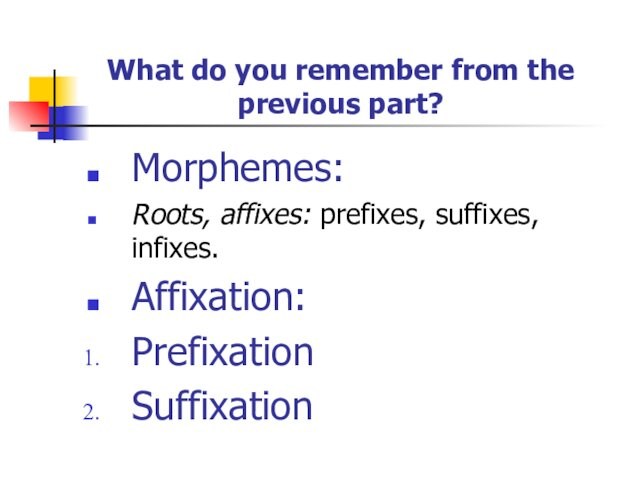
Roots, affixes: prefixes, suffixes, infixes.
Affixation:
Prefixation
Suffixation
Слайд 3
1. Conversion (zero derivation)
is making a new word
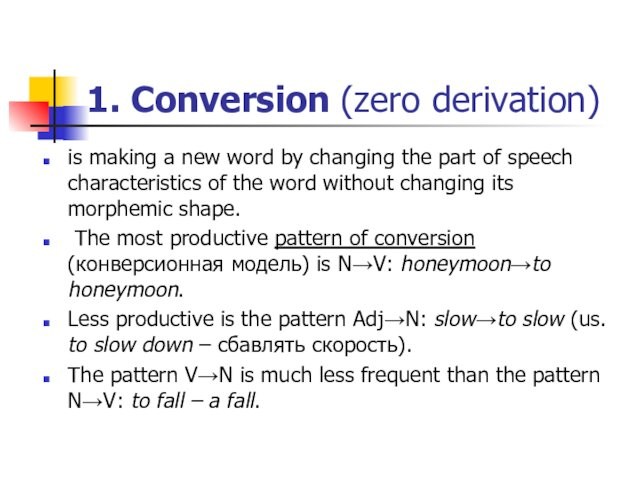
by changing the part of speech characteristics of the
word without changing its morphemic shape.
The most productive
pattern of conversion (конверсионная модель) is N→V: honeymoon→to honeymoon.
Less productive is the pattern Adj→N: slow→to slow (us. to slow down – сбавлять скорость).
The pattern V→N is much less frequent than the pattern N→V: to fall – a fall.
Слайд 4
Conversion
Noun-verb conversion
He elbowed his way through the crowd.
Problems
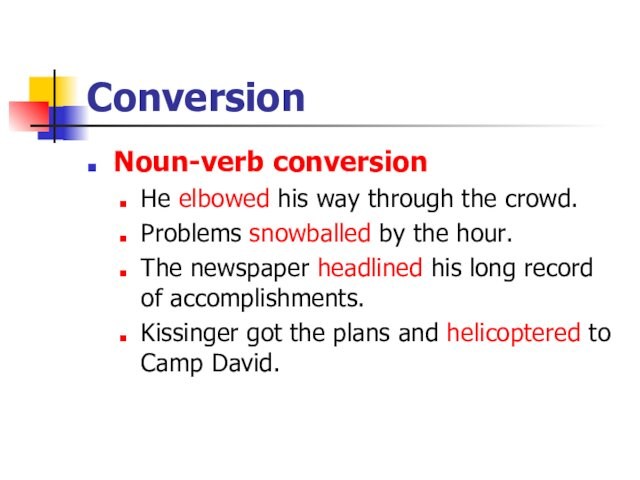
snowballed by the hour.
The newspaper headlined his long record
of accomplishments.
Kissinger got the plans and helicoptered to Camp David.
Слайд 5
Conversion
Verb-noun conversion
He was admitted to the university after
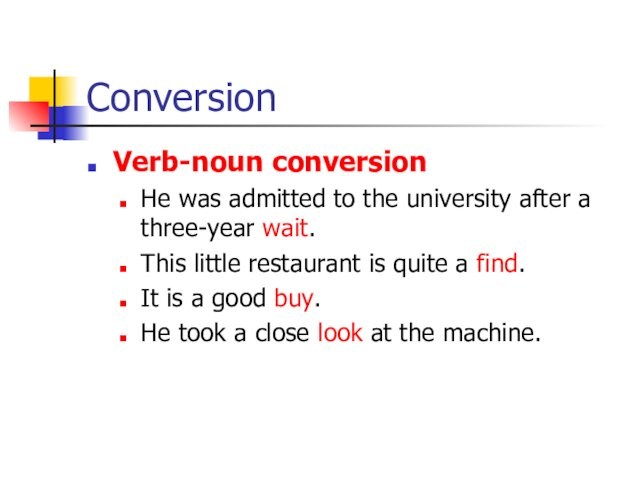
a three-year wait.
This little restaurant is quite a find.
It
is a good buy.
He took a close look at the
machine.
Слайд 6
Conversion
Verb-noun conversion
Phrasal verb-noun conversion
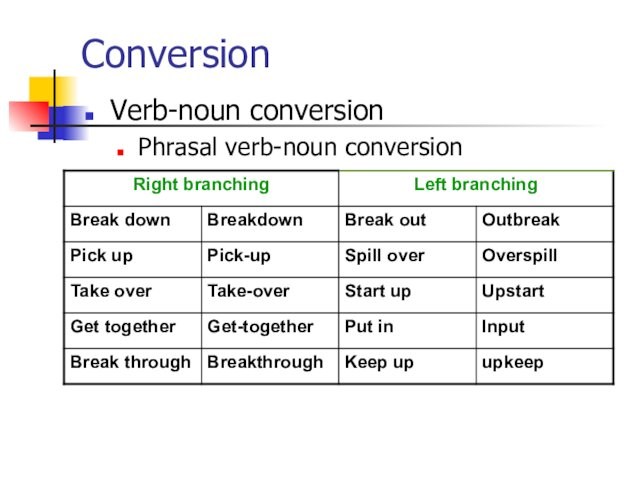
Слайд 7
Conversion
Adjective-noun conversion
1. Partial conversion
Denoting a quality or a
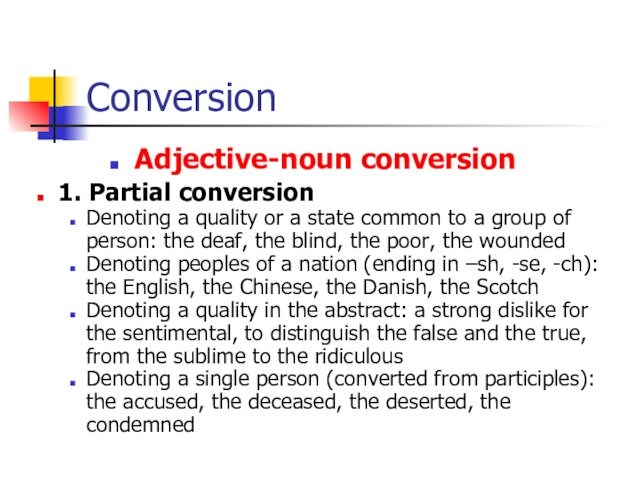
state common to a group of person: the deaf,
the blind, the poor, the wounded
Denoting peoples of a nation
(ending in –sh, -se, -ch): the English, the Chinese, the Danish, the Scotch
Denoting a quality in the abstract: a strong dislike for the sentimental, to distinguish the false and the true, from the sublime to the ridiculous
Denoting a single person (converted from participles): the accused, the deceased, the deserted, the condemned
Слайд 8
Conversion
Adjective-noun conversion
2. Complete conversion
A native, two natives, a
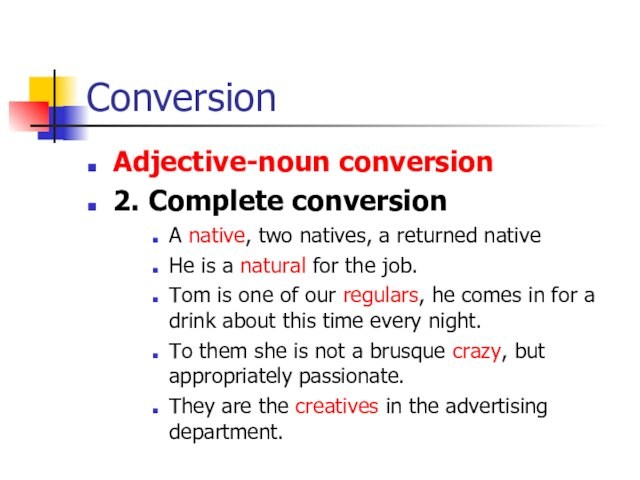
returned native
He is a natural for the job.
Tom is
one of our regulars, he comes in for a drink
about this time every night.
To them she is not a brusque crazy, but appropriately passionate.
They are the creatives in the advertising department.
Слайд 9
2. Compounding
Compounding or composition
is a word-formation process consisting
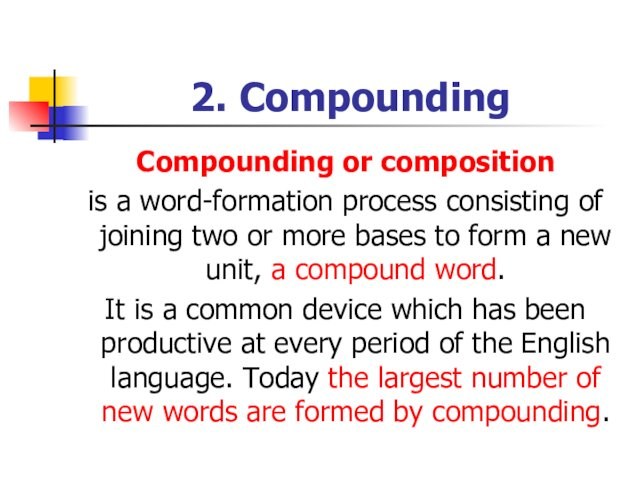
of joining two or more bases to form a
new unit, a compound word.
It is a common device
which has been productive at every period of the English language. Today the largest number of new words are formed by compounding.
Слайд 10
Compounding
Type of composition:
Solid (without linking elements): bedtime, honeymoon
With
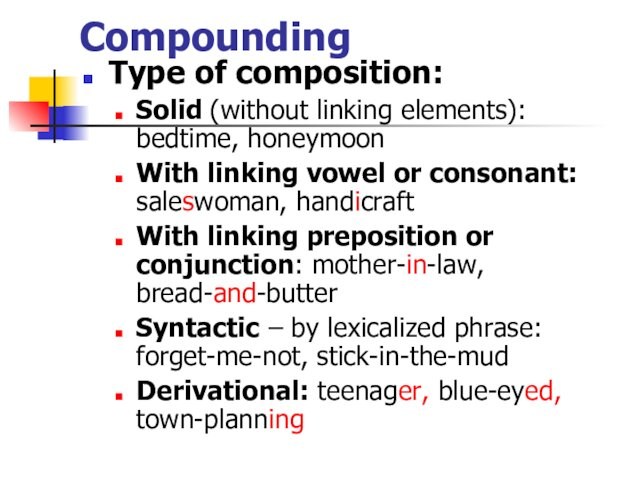
linking vowel or consonant: saleswoman, handicraft
With linking preposition or
conjunction: mother-in-law, bread-and-butter
Syntactic – by lexicalized phrase: forget-me-not, stick-in-the-mud
Derivational:
teenager, blue-eyed, town-planning
Слайд 11
Compounding
Structure of the compounds:
1) two simple stems: pen-knife,
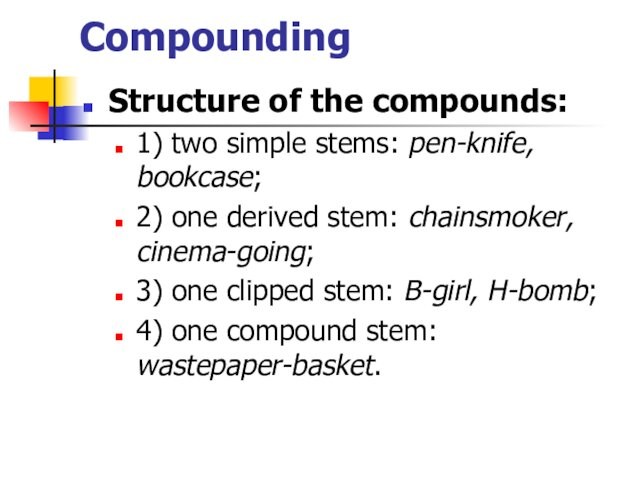
bookcase;
2) one derived stem: chainsmoker, cinema-going;
3) one clipped stem:
B-girl, H-bomb;
4) one compound stem: wastepaper-basket.
Слайд 12
3. Shortening (Clipping or Curtailment)
Types of shortening or

abbreviation
1) clipped words: those created by clipping part of
the word (usually a noun), leaving only a piece of
the old word. The clipped form is normally regarded as informal.
Слайд 13
Shortening
Clipped words can be of different types:
ad=advertisement
expo=exposition
phone=telephone
pro=professional
memo=memorandum
tec=detective
heli or
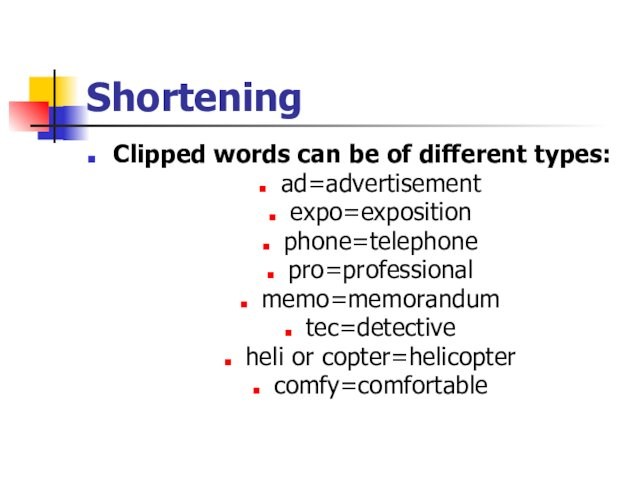
copter=helicopter
comfy=comfortable
Слайд 14
Shortening
2) initialisms (инициальная аббревиатура): a type of shortening,
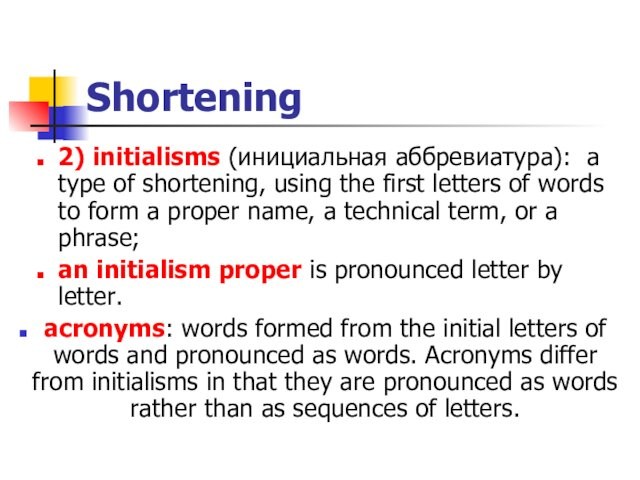
using the first letters of words to form a
proper name, a technical term, or a phrase;
an initialism
proper is pronounced letter by letter.
acronyms: words formed from the initial letters of words and pronounced as words. Acronyms differ from initialisms in that they are pronounced as words rather than as sequences of letters.
Слайд 15
Shortening
examples
IOC=International Olympic Committee
BBC=British Broadcasting Corporation
ISBN=International Standard Book Number
CAD=computer
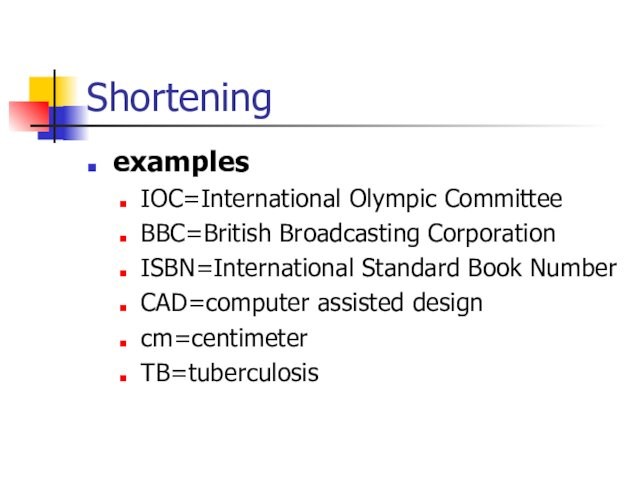
assisted design
cm=centimeter
TB=tuberculosis
Слайд 16
Shortening
examples
Basic=Beginner’s All-purpose Symbolic Instruction
TEFL=teaching English as a foreign
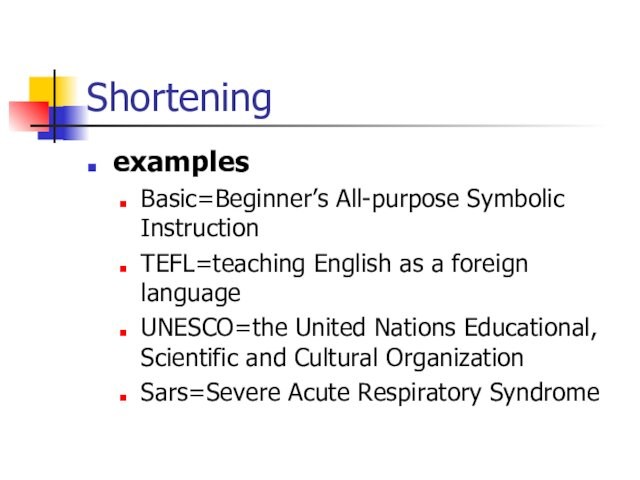
language
UNESCO=the United Nations Educational, Scientific and Cultural Organization
Sars=Severe Acute
Respiratory Syndrome
Слайд 17
Shortening
gymnasium
dormitory
handkerchief
gasoline
kilogram
influenza
business
parachute

refrigerator
taxicab
gym
dorm
hanky
Gas
kilo
flu
biz
chute
fridge
taxi or cab
Give clippings for the following
words
Слайд 18
Shortening
CPU
DIY
CEO
IT
AI
SOS
IDD
GMT
VIP
P.S.
a.m.
p.m.
central processing unit
Do it yourself
Chief Executive Officer
Information
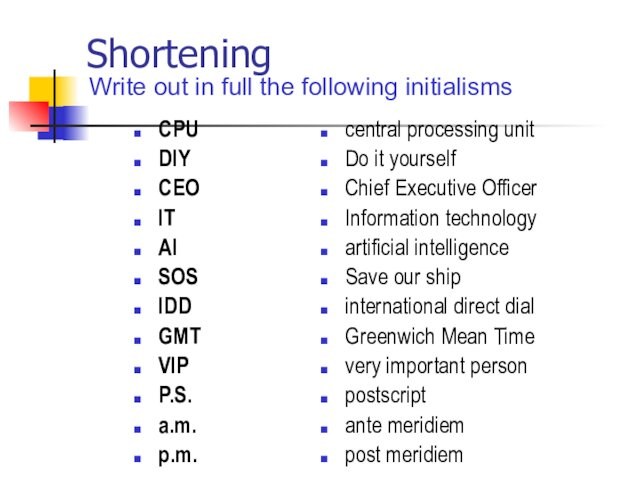
technology
artificial intelligence
Save our ship
international direct dial
Greenwich Mean Time
very important
person
postscript
ante meridiem
post meridiem
Write out in full the following initialisms
Слайд 19
4. Backformation (Обратное словообразование)
Back-formation is a process of
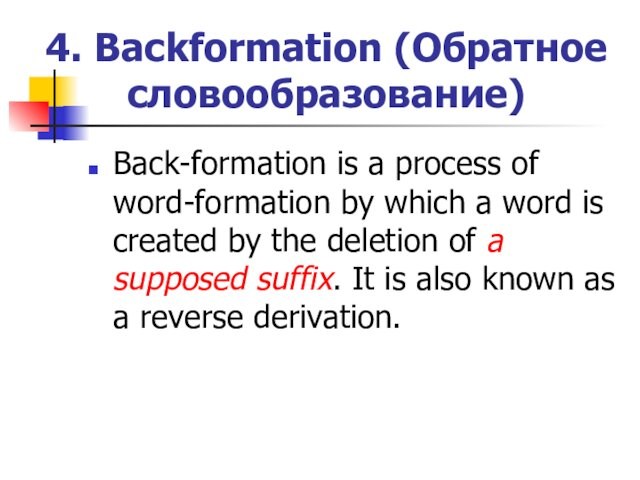
word-formation by which a word is created by the
deletion of a supposed suffix. It is also known as
a reverse derivation.
Слайд 20
Backformation
Examples
edit from editor
automate from automation
enthuse from enthusiasm
gloom from
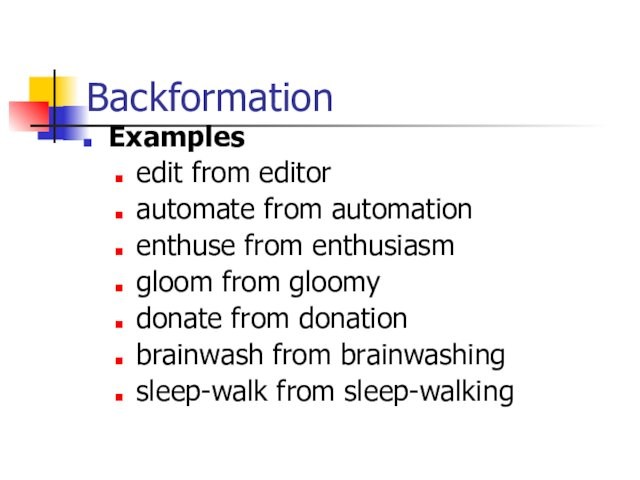
gloomy
donate from donation
brainwash from brainwashing
sleep-walk from sleep-walking
Слайд 21
5.Blending Контаминация
Blending is a process of word-formation in
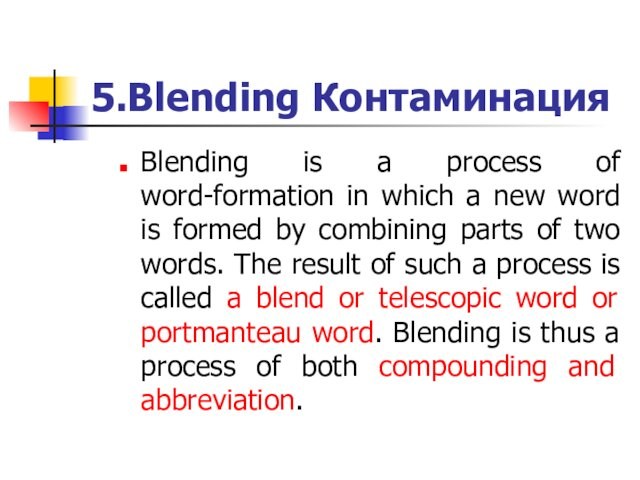
which a new word is formed by combining parts
of two words. The result of such a process is
called a blend or telescopic word or portmanteau word. Blending is thus a process of both compounding and abbreviation.
Слайд 22
Blending
Examples
newscast (news+broadcast)
brunch (breakfast+lunch)
smog (smoke+fog)
talkathon (talk+marathon)

slimnastics (slim+gymnastics)
videophone ( video +telephone)
Слайд 23
Blending
sci-fi
hi-fi
workaholic
stagflation
Unicom
sitcom
motel
dawk
science+fiction
high+fidelity
work+alcoholic
stagnation+inflation
United + Communications
situation+comedy
motor+hotel
dove+hawk
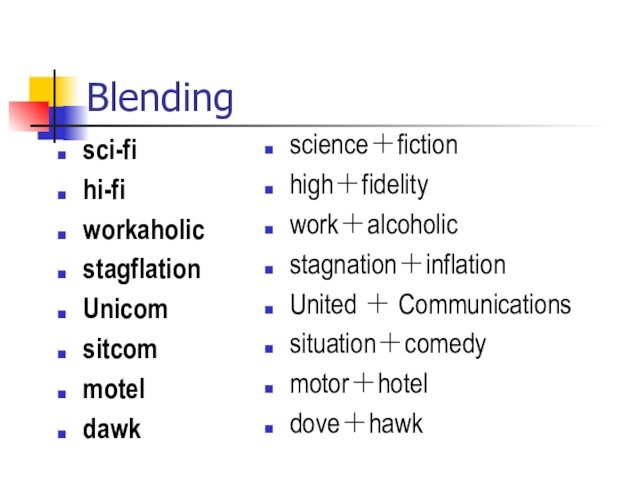
Слайд 24
6. Less productive
and non-productive
ways of
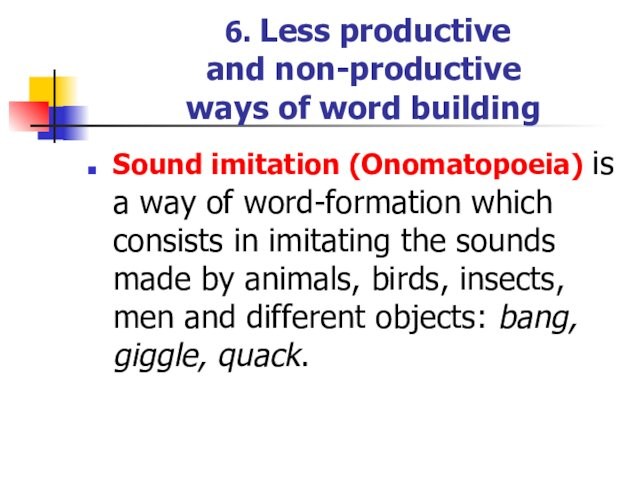
word building
Sound imitation (Onomatopoeia) is a way of word-formation
which consists in imitating the sounds made by animals, birds,
insects, men and different objects: bang, giggle, quack.
Слайд 25
Reduplication (Repetition)
consists in a complete or partial
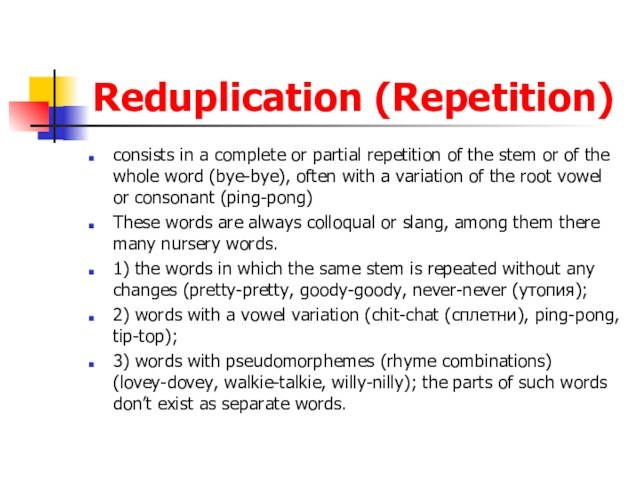
repetition of the stem or of the whole word
(bye-bye), often with a variation of the root vowel or
consonant (ping-pong)
These words are always colloqual or slang, among them there many nursery words.
1) the words in which the same stem is repeated without any changes (pretty-pretty, goody-goody, never-never (утопия);
2) words with a vowel variation (chit-chat (сплетни), ping-pong, tip-top);
3) words with pseudomorphemes (rhyme combinations) (lovey-dovey, walkie-talkie, willy-nilly); the parts of such words don’t exist as separate words.
Слайд 26
Ellipsis
is the omission of a word or
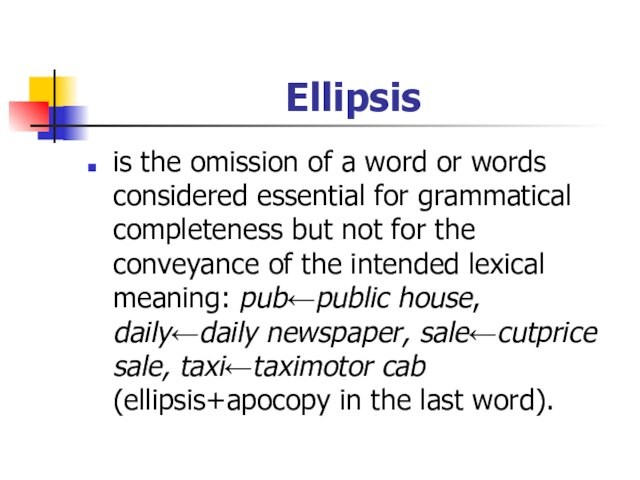
words considered essential for grammatical completeness but not for
the conveyance of the intended lexical meaning: pub←public house, daily←daily
newspaper, sale←cutprice sale, taxi←taximotor cab (ellipsis+apocopy in the last word).
Слайд 27
Non-productive ways of word-building
Sound interchange :
vowel-interchange (to sing
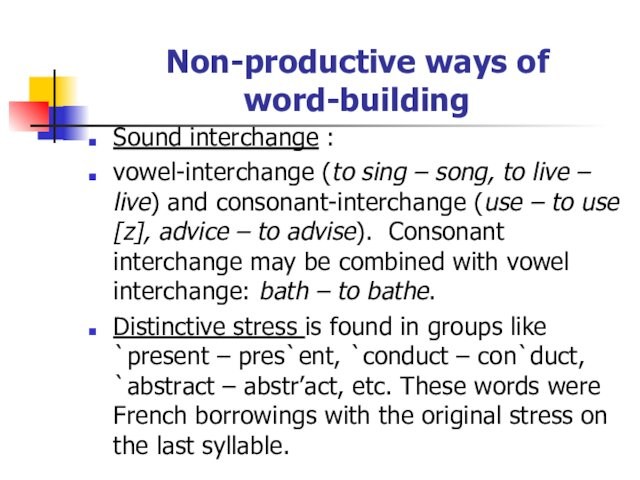
– song, to live – live) and consonant-interchange (use
– to use [z], advice – to advise). Consonant interchange
may be combined with vowel interchange: bath – to bathe.
Distinctive stress is found in groups like `present – pres`ent, `conduct – con`duct, `abstract – abstr’act, etc. These words were French borrowings with the original stress on the last syllable.
Слайд 28
Why should you know the ways of word-building


































